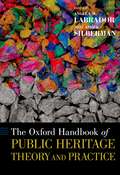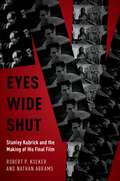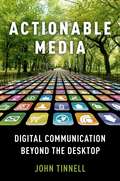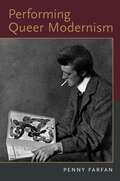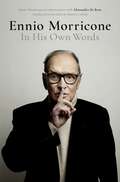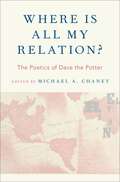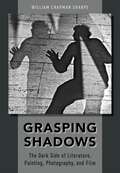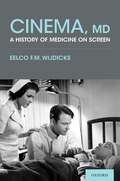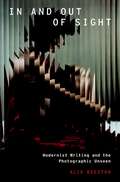- Table View
- List View
The Oxford Handbook of Public Heritage Theory and Practice (Oxford Handbooks)
by Angela M. Labrador and Neil Asher SilbermanThe field of cultural heritage is no longer solely dependent on the expertise of art and architectural historians, archaeologists, conservators, curators, and site and museum administrators. It has dramatically expanded across disciplinary boundaries and social contexts, with even the basic definition of what constitutes cultural heritage being widened far beyond the traditional categories of architecture, artifacts, archives, and art. Heritage now includes vernacular architecture, intangible cultural practices, knowledge, and language, performances and rituals, as well as cultural landscapes. Heritage has also become increasingly entangled with the broader social, political, and economic contexts in which heritage is created, managed, transmitted, protected, or even destroyed. Heritage protection now encompasses a growing set of methodological approaches whose objectives are not necessarily focused upon the maintenance of material fabric, which has traditionally been cultural heritage's primary concern. The Oxford Handbook of Public Heritage Theory and Practice charts some of the major sites of convergence between the humanities and the social sciences, where new disciplinary perspectives are being brought to bear on heritage. These convergences have the potential to provide the interdisciplinary expertise needed not only to critique but also to achieve the intertwined intellectual, political, and socioeconomic goals of cultural heritage in the twenty-first century. This volume highlights the potential contributions of development studies, political science, anthropology, management studies, human geography, ecology, psychology, sociology, cognitive studies, and education to heritage studies.
Eyes Wide Shut: Stanley Kubrick and the Making of His Final Film
by Robert P. Kolker Nathan AbramsTwenty years since its release, Stanley Kubrick's Eyes Wide Shut remains a complex, visually arresting film about domesticity, sexual disturbance, and dreams. It was on the director's mind for some 50 years before he finally put it into production. Using the Stanley Kubrick Archive at the University of the Arts, London, and interviews with participants in the production, the authors create an archeology of the film that traces the progress of the film from its origins to its completion, reception, and afterlife. The book is also an appreciation of this enigmatic work and its equally enigmatic creator.
Eyes Wide Shut: Stanley Kubrick and the Making of His Final Film
by Robert P. Kolker Nathan AbramsTwenty years since its release, Stanley Kubrick's Eyes Wide Shut remains a complex, visually arresting film about domesticity, sexual disturbance, and dreams. It was on the director's mind for some 50 years before he finally put it into production. Using the Stanley Kubrick Archive at the University of the Arts, London, and interviews with participants in the production, the authors create an archeology of the film that traces the progress of the film from its origins to its completion, reception, and afterlife. The book is also an appreciation of this enigmatic work and its equally enigmatic creator.
Actionable Media: Digital Communication Beyond the Desktop
by John TinnellIn 1991, Mark Weiser and his team at Xerox PARC declared they were reinventing computers for the twenty-first century. The computer would become integrated into the fabric of everyday life; it would shift to the background rather than being itself an object of focus. The resulting rise of ubiquitous computing (smartphones, smartglasses, smart cities) have since thoroughly colonized our digital landscape. In Actionable Media, John Tinnell contends that there is an unsung rhetorical dimension to Weiser's legacy, which stretches far beyond recent iProducts. Taking up Weiser's motto, "Start from the arts and humanities," Tinnell develops a theoretical framework for understanding nascent initiatives--the Internet of things, wearable interfaces, augmented reality--in terms of their intellectual history, their relationship to earlier communication technologies, and their potential to become vibrant platforms for public culture and critical media production. It is clear that an ever-widening array of everyday spaces now double as venues for multimedia authorship. Writers, activists, and students, in cities and towns everywhere, are digitally augmenting physical environments. Audio walks embed narratives around local parks for pedestrians to encounter during a stroll; online forums are woven into urban infrastructure and suburban plazas to invigorate community politics. This new wave of digital communication, which Tinnell terms "actionable media," is presented through case studies of exemplar projects by leading artists, designers, and research-creation teams. Chapters alter notions of ubiquitous computing through concepts drawn from Bernard Stiegler, Gregory Ulmer, and Hannah Arendt; from comparative media analyses with writing systems such as cuneiform, urban signage, and GUI software; and from relevant stylistic insights gleaned from the open air arts practices of Augusto Boal, Claude Monet, and Janet Cardiff. Actionable Media challenges familiar claims about the combination of physical and digital spaces, beckoning contemporary media studies toward an alternative substrate of historical precursors, emerging forms, design philosophies, and rhetorical principles.
ACTIONABLE MEDIA C: Digital Communication Beyond the Desktop
by John TinnellIn 1991, Mark Weiser and his team at Xerox PARC declared they were reinventing computers for the twenty-first century. The computer would become integrated into the fabric of everyday life; it would shift to the background rather than being itself an object of focus. The resulting rise of ubiquitous computing (smartphones, smartglasses, smart cities) have since thoroughly colonized our digital landscape. In Actionable Media, John Tinnell contends that there is an unsung rhetorical dimension to Weiser's legacy, which stretches far beyond recent iProducts. Taking up Weiser's motto, "Start from the arts and humanities," Tinnell develops a theoretical framework for understanding nascent initiatives--the Internet of things, wearable interfaces, augmented reality--in terms of their intellectual history, their relationship to earlier communication technologies, and their potential to become vibrant platforms for public culture and critical media production. It is clear that an ever-widening array of everyday spaces now double as venues for multimedia authorship. Writers, activists, and students, in cities and towns everywhere, are digitally augmenting physical environments. Audio walks embed narratives around local parks for pedestrians to encounter during a stroll; online forums are woven into urban infrastructure and suburban plazas to invigorate community politics. This new wave of digital communication, which Tinnell terms "actionable media," is presented through case studies of exemplar projects by leading artists, designers, and research-creation teams. Chapters alter notions of ubiquitous computing through concepts drawn from Bernard Stiegler, Gregory Ulmer, and Hannah Arendt; from comparative media analyses with writing systems such as cuneiform, urban signage, and GUI software; and from relevant stylistic insights gleaned from the open air arts practices of Augusto Boal, Claude Monet, and Janet Cardiff. Actionable Media challenges familiar claims about the combination of physical and digital spaces, beckoning contemporary media studies toward an alternative substrate of historical precursors, emerging forms, design philosophies, and rhetorical principles.
Performing Queer Modernism
by Penny FarfanFocusing on some of the best-known and most visible stage plays and dance performances of the late nineteenth- and early twentieth-centuries, Penny Farfan's interdisciplinary study demonstrates that queer performance was integral to and productive of modernism, that queer modernist performance played a key role in the historical emergence of modern sexual identities, and that it anticipated, and was in a sense foundational to, the insights of contemporary queer modernist studies. Chapters on works from Vaslav Nijinsky's Afternoon of a Faun to Noël Coward's Private Lives highlight manifestations of and suggest ways of reading queer modernist performance. Together, these case studies clarify aspects of both the queer and the modernist, and how their co-productive intersection was articulated in and through performance on the late-nineteenth- and early-twentieth-century stage. Performing Queer Modernism thus contributes to an expanded understanding of modernism across a range of performance genres, the central role of performance within modernism more generally, and the integral relation between performance history and the history of sexuality. It also contributes to the ongoing transformation of the field of modernist studies, in which drama and performance remain under-represented, and to revisionist historiographies that approach modernist performance through feminist and queer critical perspectives and interdisciplinary frameworks and that consider how formally innovative as well as more conventional works collectively engaged with modernity, at once reflecting and contributing to historical change in the domains of gender and sexuality.
PERFORMING QUEER MODERNISM C
by Penny FarfanFocusing on some of the best-known and most visible stage plays and dance performances of the late nineteenth- and early twentieth-centuries, Penny Farfan's interdisciplinary study demonstrates that queer performance was integral to and productive of modernism, that queer modernist performance played a key role in the historical emergence of modern sexual identities, and that it anticipated, and was in a sense foundational to, the insights of contemporary queer modernist studies. Chapters on works from Vaslav Nijinsky's Afternoon of a Faun to Noël Coward's Private Lives highlight manifestations of and suggest ways of reading queer modernist performance. Together, these case studies clarify aspects of both the queer and the modernist, and how their co-productive intersection was articulated in and through performance on the late-nineteenth- and early-twentieth-century stage. Performing Queer Modernism thus contributes to an expanded understanding of modernism across a range of performance genres, the central role of performance within modernism more generally, and the integral relation between performance history and the history of sexuality. It also contributes to the ongoing transformation of the field of modernist studies, in which drama and performance remain under-represented, and to revisionist historiographies that approach modernist performance through feminist and queer critical perspectives and interdisciplinary frameworks and that consider how formally innovative as well as more conventional works collectively engaged with modernity, at once reflecting and contributing to historical change in the domains of gender and sexuality.
Ennio Morricone: In His Own Words
Master composer Ennio Morricone's scores go hand-in-hand with the idea of the Western film. Often considered the world's greatest living film composer, and most widely known for his innovative scores to The Good, the Bad, and the Ugly and the other Sergio Leone's movies, The Mission, Cinema Paradiso and more recently, The Hateful Eight, Morricone has spent the past 60 years reinventing the sound of cinema. In Ennio Morricone: In His Own Words, composers Ennio Morricone and Alessandro De Rosa present a years-long discussion of life, music, and the marvelous and unpredictable ways that the two come into contact with and influence each other. The result is what Morricone himself defines: "beyond a shadow of a doubt the best book ever written about me, the most authentic, the most detailed and well curated. The truest." Opening for the first time the door of his creative laboratory, Morricone offers an exhaustive and rich account of his life, from his early years of study to genre-defining collaborations with the most important Italian and international directors, including Leone, Bertolucci, Pasolini, Argento, Tornatore, Malick, Carpenter, Stone, Nichols, De Palma, Beatty, Levinson, Almodóvar, Polanski, and Tarantino. In the process, Morricone unveils the curious relationship that links music and images in cinema, as well as the creative urgency at the foundation of his experimentations with "absolute music". Throughout these conversations with De Rosa, Morricone dispenses invaluable insights not only on composing but also on the broader process of adaptation and what it means to be human. As he reminds us, "Coming into contact with memories doesn't only entail the melancholy of something that slips away with time, but also looking forward, understanding who I am now. And who knows what else may still happen."
Ennio Morricone: In His Own Words
by Ennio MorriconeMaster composer Ennio Morricone's scores go hand-in-hand with the idea of the Western film. Often considered the world's greatest living film composer, and most widely known for his innovative scores to The Good, the Bad, and the Ugly and the other Sergio Leone's movies, The Mission, Cinema Paradiso and more recently, The Hateful Eight, Morricone has spent the past 60 years reinventing the sound of cinema. In Ennio Morricone: In His Own Words, composers Ennio Morricone and Alessandro De Rosa present a years-long discussion of life, music, and the marvelous and unpredictable ways that the two come into contact with and influence each other. The result is what Morricone himself defines: "beyond a shadow of a doubt the best book ever written about me, the most authentic, the most detailed and well curated. The truest." Opening for the first time the door of his creative laboratory, Morricone offers an exhaustive and rich account of his life, from his early years of study to genre-defining collaborations with the most important Italian and international directors, including Leone, Bertolucci, Pasolini, Argento, Tornatore, Malick, Carpenter, Stone, Nichols, De Palma, Beatty, Levinson, Almodóvar, Polanski, and Tarantino. In the process, Morricone unveils the curious relationship that links music and images in cinema, as well as the creative urgency at the foundation of his experimentations with "absolute music". Throughout these conversations with De Rosa, Morricone dispenses invaluable insights not only on composing but also on the broader process of adaptation and what it means to be human. As he reminds us, "Coming into contact with memories doesn't only entail the melancholy of something that slips away with time, but also looking forward, understanding who I am now. And who knows what else may still happen."
The Framing of Sacred Space: The Canopy and the Byzantine Church
by Jelena BogdanovicThe Framing of Sacred Space offers the first topical study of canopies as essential spatial and symbolic units in Byzantine-rite churches. Centrally planned columnar structures--typically comprised of four columns and a roof--canopies had a critical role in the modular processes of church design, from actual church furnishings in the shape of a canopy to the church's structural core. As architectonic objects of basic structural and design integrity, canopies integrate an archetypical image of architecture and provide means for an innovative understanding of the materialization of the idea of the Byzantine church and its multi-focal spatial presence. The Framing of Sacred Space considers both the material and conceptual framing of sacred space and explains how the canopy bridges the physical and transcendental realms. As a crucial element of church design in the Byzantine world, a world that gradually abandoned the basilica as a typical building of Roman imperial secular architecture, the canopy carried tectonic and theological meanings and, through vaulted, canopied bays and recognizable Byzantine domed churches, established organic architectural, symbolic, and sacred ties between the Old and New Covenants. In such an overarching context, the canopy becomes an architectural parti, a vital concept and dynamic design principle that carries the essence of the Byzantine church. The Framing of Sacred Space highlights significant factors in understanding canopies through specific architectural settings and the Byzantine concepts of space, thus also contributing to larger debates about the creation of sacred space and related architectural taxonomy.
Paris and the Cliché of History: The City and Photographs, 1860-1970
by Catherine E. ClarkThis book turns a compelling new lens on thinking about the history of Paris and photography. The invention of photography changed how history could be written. But the now commonplace assumptions--that photographs capture fragments of lost time or present emotional gateways to the past--that structure today's understandings did not emerge whole cloth in 1839. Focusing on one of photography's birthplaces, Paris and the Cliché of History tells the story of how photographs came to be imagined as documents of the past. Author Catherine E. Clark analyzes photography's effects on historical interpretation by examining the formation of Paris's first photo archives at the Musée Carnavalet and the city's municipal library, their use in illustrated history books and historical exhibitions and reconstructions such as the 1951 celebration of Paris's 2000th birthday, and the public's contribution to the historical record in amateur photo contests. Despite the photograph's growing importance in these forums, it did not simply replace older forms of illustration, visual documentation, or written text. Photos worked in complex and shifting relation to other types of pictures as photographers, popular historians, and publishers built on the traditions and iconography of painting and engraving in order to both document the past scientifically and objectively and to reconstruct it romantically. In doing so, they not only influenced how Parisians thought about the city's past and how they pictured it; they also ensured that these images shaped how Parisians lived their own lives--especially in deeply charged moments such as the Liberation after World War II. This history of picturing Paris does not simply reflect the city's history: it is Parisian history.
Paris and the Cliché of History: The City and Photographs, 1860-1970
by Catherine E. ClarkThis book turns a compelling new lens on thinking about the history of Paris and photography. The invention of photography changed how history could be written. But the now commonplace assumptions--that photographs capture fragments of lost time or present emotional gateways to the past--that structure today's understandings did not emerge whole cloth in 1839. Focusing on one of photography's birthplaces, Paris and the Cliché of History tells the story of how photographs came to be imagined as documents of the past. Author Catherine E. Clark analyzes photography's effects on historical interpretation by examining the formation of Paris's first photo archives at the Musée Carnavalet and the city's municipal library, their use in illustrated history books and historical exhibitions and reconstructions such as the 1951 celebration of Paris's 2000th birthday, and the public's contribution to the historical record in amateur photo contests. Despite the photograph's growing importance in these forums, it did not simply replace older forms of illustration, visual documentation, or written text. Photos worked in complex and shifting relation to other types of pictures as photographers, popular historians, and publishers built on the traditions and iconography of painting and engraving in order to both document the past scientifically and objectively and to reconstruct it romantically. In doing so, they not only influenced how Parisians thought about the city's past and how they pictured it; they also ensured that these images shaped how Parisians lived their own lives--especially in deeply charged moments such as the Liberation after World War II. This history of picturing Paris does not simply reflect the city's history: it is Parisian history.
Where Is All My Relation?: The Poetics of Dave the Potter
by Michael A. ChaneyWhere Is All My Relation? presents the first sustained academic discussion of the poetry, pottery, and culture of David Drake, an antebellum slave who distinguished himself by composing verse on the ceramics he produced in the years leading up to the Civil War. During the 1830s, 40s, and 50s, he incised couplets and signatures (a singular "Dave") onto the incredibly large storage vessels that he made. In fact, his stoneware pots and jars are among the largest made in North America during the antebellum era, and craft enthusiasts and appraisers are still proclaiming their precision and ambitious volume. Rich with biblical allusions, historical facts, and personal opinions, his art provides unique insights into the lives of slaves, craftsmen, and the culture of the American South in the first half of the nineteenth century. The essays here engage with the historical context and major issues that Drake's work provokes, among them: prohibitions against slave literacy; Drake's privileged status compared to other slaves at the time; the interpretive status of his material craft objects; the influence of contemporary African American poet George Moses Horton; and Drake's ability to sell his pottery despite the fact that slaves were not officially permitted to participate in a cash economy. Featuring essays by literary critics, art-historians, archaeologists, and curators, Where Is All My Relation? provides a window into the world of nineteenth century material culture and expands our traditional understanding of the slave-narrative genre.
Grasping Shadows: The Dark Side of Literature, Painting, Photography, and Film
by William Chapman SharpeWhat's in a shadow? Menace, seduction, or salvation? Immaterial but profound, shadows lurk everywhere in literature and the visual arts, signifying everything from the treachery of appearances to the unfathomable power of God. From Plato to Picasso, from Rembrandt to Welles and Warhol, from Lord of the Rings to the latest video game, shadows act as central players in the drama of Western culture. Yet because they work silently, artistic shadows often slip unnoticed past audiences and critics. Conceived as an accessible introduction to this elusive phenomenon, Grasping Shadows is the first book that offers a general theory of how all shadows function in texts and visual media. Arguing that shadow images take shape within a common cultural field where visual and verbal meanings overlap, William Sharpe ranges widely among classic and modern works, revealing the key motifs that link apparently disparate works such as those by Fra Angelico and James Joyce, Clementina Hawarden and Kara Walker, Charles Dickens and Kumi Yamashita. Showing how real-world shadows have shaped the meanings of shadow imagery, Grasping Shadows guides the reader through the techniques used by writers and artists to represent shadows from the Renaissance onward. The last chapter traces how shadows impact the art of the modern city, from Renoir and Zola to film noir and projection systems that capture the shadows of passers-by on streets around the globe. Extending his analysis to contemporary street art, popular songs, billboards, and shadow-theatre, Sharpe demonstrates a practical way to grasp the "dark side" that looms all around us.
Grasping Shadows: The Dark Side of Literature, Painting, Photography, and Film
by William Chapman SharpeWhat's in a shadow? Menace, seduction, or salvation? Immaterial but profound, shadows lurk everywhere in literature and the visual arts, signifying everything from the treachery of appearances to the unfathomable power of God. From Plato to Picasso, from Rembrandt to Welles and Warhol, from Lord of the Rings to the latest video game, shadows act as central players in the drama of Western culture. Yet because they work silently, artistic shadows often slip unnoticed past audiences and critics. Conceived as an accessible introduction to this elusive phenomenon, Grasping Shadows is the first book that offers a general theory of how all shadows function in texts and visual media. Arguing that shadow images take shape within a common cultural field where visual and verbal meanings overlap, William Sharpe ranges widely among classic and modern works, revealing the key motifs that link apparently disparate works such as those by Fra Angelico and James Joyce, Clementina Hawarden and Kara Walker, Charles Dickens and Kumi Yamashita. Showing how real-world shadows have shaped the meanings of shadow imagery, Grasping Shadows guides the reader through the techniques used by writers and artists to represent shadows from the Renaissance onward. The last chapter traces how shadows impact the art of the modern city, from Renoir and Zola to film noir and projection systems that capture the shadows of passers-by on streets around the globe. Extending his analysis to contemporary street art, popular songs, billboards, and shadow-theatre, Sharpe demonstrates a practical way to grasp the "dark side" that looms all around us.
Philosophy and the Moving Image (Thinking Art)
by Noël CarrollA wide-ranging, eclectic collection of essays on philosophy and the moving image by a pre-eminent philosopher of art This volume presents a selection of philosopher Noël Carroll's essays-several of which appear in print here for the first time-at the intersection of philosophy, film, and television. The volume begins with broad, foundational issues-what the moving image is, the nature of the medium of film and how we should evaluate it-engaging critically with the most essential problems and puzzles in the field. Carroll then moves to more focused issues in the philosophy of film and television. He reflects on whether ethical defects in fictional characters such as Tony Soprano have an impact on artistic excellence; the role of films in political debates (using the examples of Star Trek and Planet of the Apes); the question of whether film can do philosophy in its own way; and philosophical themes in avant-garde cinema. His analysis touches on a broad range of areas in philosophy including metaphysics, epistemology, ethics, politics, and aesthetics. The book then concludes with philosophical re-assessments of key figures in the philosophy of the moving image-Sergei Eisenstein, Arthur Danto, Bela Balasz, and Stanley Cavell. A wide-ranging and eclectic collection of work by a major figure in aesthetics and the philosophy of film and television, this volume will appeal to scholars, students, and cinephiles alike.
Philosophy and the Moving Image (Thinking Art)
by Noël CarrollA wide-ranging, eclectic collection of essays on philosophy and the moving image by a pre-eminent philosopher of art This volume presents a selection of philosopher Noël Carroll's essays-several of which appear in print here for the first time-at the intersection of philosophy, film, and television. The volume begins with broad, foundational issues-what the moving image is, the nature of the medium of film and how we should evaluate it-engaging critically with the most essential problems and puzzles in the field. Carroll then moves to more focused issues in the philosophy of film and television. He reflects on whether ethical defects in fictional characters such as Tony Soprano have an impact on artistic excellence; the role of films in political debates (using the examples of Star Trek and Planet of the Apes); the question of whether film can do philosophy in its own way; and philosophical themes in avant-garde cinema. His analysis touches on a broad range of areas in philosophy including metaphysics, epistemology, ethics, politics, and aesthetics. The book then concludes with philosophical re-assessments of key figures in the philosophy of the moving image-Sergei Eisenstein, Arthur Danto, Bela Balasz, and Stanley Cavell. A wide-ranging and eclectic collection of work by a major figure in aesthetics and the philosophy of film and television, this volume will appeal to scholars, students, and cinephiles alike.
The Free Voice: A Guide to Natural Singing
by Cornelius L. ReidGreat vocal teachers from the 16th century through the early 19th century discovered through trial and error how to properly develop the singing voice, and the term bel canto came to be applied to both the manner of singing and the vocal music of that period. But by 1858, according to Rossini, the term was already being misused and wrongly confused with fioriture. Well-schooled in the teaching of singing, Rossini more accurately describes bel canto as being composed of: the building of the instrument; technique, or the means of using the instrument; and style, of which the ingredients are taste and feeling. In this 50th anniversary edition of The Free Voice, renowned vocal pedagogue Cornelius L. Reid articulates the teaching principles of his own school of functional vocal training, grounded firmly in the old principles while remaining in line with a modern understanding of the physical value of the vocal instrument. The muscles that move the vocal folds and the vocal folds themselves are involuntary, and as such, the singing voice is not an instrument that can be manipulated directly. Reid's approach to singing is one of indirect control, stemming from an understanding of the vocal registers and how specific patterns of pitch, intensity, and vowel affect the vocal folds. Through the vocal exercises outlined in this book, and catered to each individual, a poorly coordinated musculature can be brought to efficiency. Only when the musculature of the vocal mechanism is well-balanced and coordinated can the voice be free, and the natural beauty and resonance of the individual voice come through without force.
FREE VOICE C: A Guide to Natural Singing
by Cornelius L. ReidGreat vocal teachers from the 16th century through the early 19th century discovered through trial and error how to properly develop the singing voice, and the term bel canto came to be applied to both the manner of singing and the vocal music of that period. But by 1858, according to Rossini, the term was already being misused and wrongly confused with fioriture. Well-schooled in the teaching of singing, Rossini more accurately describes bel canto as being composed of: the building of the instrument; technique, or the means of using the instrument; and style, of which the ingredients are taste and feeling. In this 50th anniversary edition of The Free Voice, renowned vocal pedagogue Cornelius L. Reid articulates the teaching principles of his own school of functional vocal training, grounded firmly in the old principles while remaining in line with a modern understanding of the physical value of the vocal instrument. The muscles that move the vocal folds and the vocal folds themselves are involuntary, and as such, the singing voice is not an instrument that can be manipulated directly. Reid's approach to singing is one of indirect control, stemming from an understanding of the vocal registers and how specific patterns of pitch, intensity, and vowel affect the vocal folds. Through the vocal exercises outlined in this book, and catered to each individual, a poorly coordinated musculature can be brought to efficiency. Only when the musculature of the vocal mechanism is well-balanced and coordinated can the voice be free, and the natural beauty and resonance of the individual voice come through without force.
Cinema, MD: A History of Medicine On Screen
by Eelco F.M. WijdicksCinema, MD follows the intersection of medicine and film and how filmmakers wrote a history of medicine over time. The narrative follows several main story lines: How did the portrayal of physicians, nurses, and medical institutions change over the years? What interested filmmakers, and which topics had priority? What does film's obsession with experiments and monstrosities reveal about medical ethics and malpractice? How could the public's perception of the medical profession change when watching these films on diseases and treatments, including palliative care and medical ethics? Are screenwriters, actors, and film directors channeling a popular view of medicine? Cinema, MD analyzes not only changing practices, changing morals, and changing expectations but also medical stereotypes, medical activism, and violations of patients' integrity and autonomy. Examining over 400 films with medical themes over a century of cinema, this book establishes the cultural, medical, and historical importance of the art form. Film allows us to see our humanity, our frailty, and our dependence when illness strikes. Cinema, MD provides uniquely new and fascinating insight into both film criticism and the history of medicine and has a resonance to the medical world we live in today.
Cinema, MD: A History of Medicine On Screen
by Eelco F.M. WijdicksCinema, MD follows the intersection of medicine and film and how filmmakers wrote a history of medicine over time. The narrative follows several main story lines: How did the portrayal of physicians, nurses, and medical institutions change over the years? What interested filmmakers, and which topics had priority? What does film's obsession with experiments and monstrosities reveal about medical ethics and malpractice? How could the public's perception of the medical profession change when watching these films on diseases and treatments, including palliative care and medical ethics? Are screenwriters, actors, and film directors channeling a popular view of medicine? Cinema, MD analyzes not only changing practices, changing morals, and changing expectations but also medical stereotypes, medical activism, and violations of patients' integrity and autonomy. Examining over 400 films with medical themes over a century of cinema, this book establishes the cultural, medical, and historical importance of the art form. Film allows us to see our humanity, our frailty, and our dependence when illness strikes. Cinema, MD provides uniquely new and fascinating insight into both film criticism and the history of medicine and has a resonance to the medical world we live in today.
The Optical Vacuum: Spectatorship and Modernized American Theater Architecture
by Jocelyn Szczepaniak-GilleceBetween the 1920s and the 1960s, American mainstream cinematic architecture underwent a seismic shift. From the massive movie palace to the intimate streamlined theater, movie theaters became neutralized spaces for calibrated, immersive watching. Leading this charge was New York architect Benjamin Schlanger, a fiery polemicist whose designs and essays reshaped how movies were watched. In its close examination of Schlanger's work and of changing patterns of spectatorship, this book reveals that the essence of film viewing lies not only in the text, but in the spaces where movies are shown. The Optical Vacuum demonstrates that our changing models of cinephilia are always determined by physical structure: from the decorations of the palace to the black box of the contemporary auditorium, variations in movie theater design are icons for how viewing has similarly transformed.
The Optical Vacuum: Spectatorship and Modernized American Theater Architecture
by Jocelyn Szczepaniak-GilleceBetween the 1920s and the 1960s, American mainstream cinematic architecture underwent a seismic shift. From the massive movie palace to the intimate streamlined theater, movie theaters became neutralized spaces for calibrated, immersive watching. Leading this charge was New York architect Benjamin Schlanger, a fiery polemicist whose designs and essays reshaped how movies were watched. In its close examination of Schlanger's work and of changing patterns of spectatorship, this book reveals that the essence of film viewing lies not only in the text, but in the spaces where movies are shown. The Optical Vacuum demonstrates that our changing models of cinephilia are always determined by physical structure: from the decorations of the palace to the black box of the contemporary auditorium, variations in movie theater design are icons for how viewing has similarly transformed.
In and Out of Sight: Modernist Writing and the Photographic Unseen
by Alix BeestonIn a post-digital media landscape tracked endlessly by streams and feeds of images, it is clearer than ever that photography is an art poised between arresting singularity and ambiguous plurality. Drawing on work in visual culture studies that emphasizes the interplay between still and moving images, In and Out of Sight provides a provocative new account of the relationship between photography and modernist literature--a literature which has long been considered to trace, in its formal experimentation, the influence of modern visual technologies. Making pioneering claims about the importance of photography to the writing of Gertrude Stein, Jean Toomer, John Dos Passos, and F. Scott Fitzgerald, Alix Beeston traverses the history of photography in the late nineteenth and early twentieth centuries. From the composite experiments of Francis Galton to the epic portrait project of August Sander; from the surrealist self-fashioning of Claude Cahun to the reappropriation of lynching photographs by black activist groups; from the collectable postcards of Broadway stars to the glamour shots of Hollywood celebrities-these and other serialized photographic projects provide essential contexts for understanding the fragmentary, composite forms of literary modernism. In a series of richly detailed literary analyses, Beeston argues that the gaps and intervals of the composite literary text model the visual syntax of photography--as well as its silences, absences, and equivocations. In them, the social and political order of modernity is negotiated and reshaped. Moving in and out of these textual openings, In and Out of Sight pursues the fleeting, visible and invisible figure of the woman-in-series, who recasts absence and silence as forms of presence and witness. This shadowy figure emerges as central to the conceptual space of modernist literature--a terrain not only gendered but radically constructed around the instability of female bodies and their desires.
Building the Classical World: Bauforschung as a Contemporary Approach
by Elisha Ann Dumser Dorian BorbonusThis multiauthor volume presents thirteen case studies that showcase the scientific, analytical, and often archaeological study of historic buildings that is known in German as Bauforschung. Written by established and emerging experts in this field, the chapters focus on the architecture of the Classical world and cover a wide variety of topics, such as construction processes, design principles, building traditions, and historical contexts. Despite this diversity, there is a common thread, since all contributors perceive architecture not as piles of dead matter, or as mere bearers of decoration and sculpture, but as dynamic organisms--bodies full of inner tension to defy gravity. Thus, they pursue the common goal to situate architecture in its historical contexts by documenting, reconstructing, and visualizing the structures as well as their spatial settings, technical underpinnings, and ideological symbolism. Throughout this volume, ancient buildings are considered historic documents in their own right, reflecting both the efforts of their designers and builders, as well as the aspirations of their patrons and communities. The collection represents a wide cross-section of approaches brought to bear on ancient Greek and Roman architecture and, thus, serves as an English-language introduction to the technical and historical questions, and the methodologies inherent in Bauforschung.
